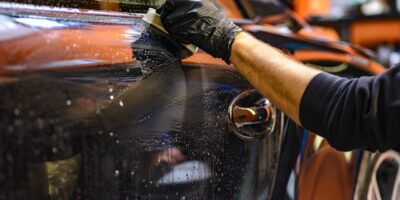Understanding Body Work on a Car
What is Body Work on a Car?
Body work on a car involves the repair and maintenance of the vehicle’s exterior. This encompasses a wide array of tasks, from fixing minor dents and scratches to significant structural repairs following an accident. Body work ensures the car looks good and maintains its structural integrity.
Types of Body Work
Several types of body work can be performed on a car, each addressing different issues and requiring specific skills and tools. These include:
- Paintless Dent Repair
- Scratch and Bumper Repair
- Panel Replacement
- Frame Straightening
- Rust Repair
Paintless Dent Repair
Paintless dent repair (PDR) is a technique used to remove minor dents and dings from the car’s surface without affecting the paint job. This method is effective for small dents caused by hail, parking accidents, or other minor impacts. Technicians use specialized tools to gently push the dent out from the underside of the panel, restoring it to its original shape.
Scratch and Bumper Repair
Scratches and bumper damage are common issues that can detract from a car’s appearance. Scratch repair often involves sanding the damaged area, applying a primer, and repainting it to match the car’s original color. Bumper repair can range from filling in minor scratches to replacing the bumper entirely if the damage is extensive.
Panel Replacement
When a car’s body panel is too damaged to be repaired, it may need to be replaced. This process involves removing the damaged panel and installing a new one. The new panel is then painted to match the rest of the car. This type of body work is more extensive and requires precision to ensure the new panel fits correctly and the paint matches seamlessly.
Frame Straightening
In the event of a major accident, a car’s frame may become bent or misaligned. Frame straightening involves using specialized equipment to straighten the frame back to its original specifications. This process is crucial for the car’s safety and performance, as a misaligned frame can affect the handling and structural integrity of the vehicle.
Rust Repair
Rust can compromise the structural integrity of a car’s body. Rust repair typically involves removing the rusted area, treating the surrounding metal to prevent further rusting, and patching the area with new metal or filler. Once the repair is complete, the area is primed and painted to match the rest of the car.
The Process of Body Work

Body work on a car generally follows a series of steps to ensure the repair is done correctly and efficiently. These steps include inspection and assessment, disassembly, repair, reassembly, and finishing.
Inspection and Assessment
The first step in any body work process is to inspect the damage and assess what needs to be done. Technicians will examine the car thoroughly, noting any dents, scratches, or structural damage. They will then create a detailed plan for the repair, including the tools and materials needed.
Disassembly
Once the assessment is complete, the damaged area is disassembled. This may involve removing panels, bumpers, or other parts to gain access to the damage. Careful disassembly is essential to avoid causing additional damage to the vehicle.
Repair
The actual repair work involves fixing the damage through various techniques, such as PDR, sanding, filling, welding, or replacing parts entirely. The goal is to restore the car to its original condition, both in terms of appearance and structural integrity.
Reassembly
After the repair work is complete, the vehicle is reassembled. This involves putting back all the parts that were removed during the disassembly phase. Technicians must ensure everything is correctly aligned and securely attached.
Finishing
The final step in the body work process is finishing. This includes painting, polishing, and detailing the car to ensure it looks as good as new. The paint is matched to the car’s original color, and the repaired area is polished to blend seamlessly with the rest of the vehicle.
Common Tools and Equipment
Body work on a car requires a variety of tools and equipment, each designed for specific tasks. Some common tools used in body work include:
- Hammer and Dolly Set
- Slide Hammer
- Body Filler and Spreaders
- Sanders and Grinders
- Paint Sprayers
- Frame Straightening Machines
Hammer and Dolly Set
A hammer and dolly set is used to shape and smooth metal panels. The hammer is used to tap the metal into place, while the dolly is held behind the panel to provide support. This tool is essential for removing dents and ensuring the panel is flush with the surrounding area.
Slide Hammer
A slide hammer is a tool used to pull out dents. It consists of a long metal rod with a handle and a weight that slides along the rod. The end of the rod is attached to the dent, and the weight is quickly slid along the rod to pull the dent out.
Body Filler and Spreaders
Body filler is a material used to fill in dents, scratches, and other imperfections in the car’s surface. It is applied with a spreader and then sanded down to create a smooth, even surface. Once the filler is properly shaped, it can be primed and painted.
Sanders and Grinders
Sanders and grinders are used to smooth out rough surfaces and prepare the car for painting. Different types of sanders and grinding wheels can be used depending on the specific task, such as removing old paint or smoothing out filler.
Paint Sprayers
Paint sprayers are used to apply a smooth, even coat of paint to the car’s surface. They can be adjusted to achieve different spray patterns and coverage, ensuring the paint job matches the car’s original finish.
Frame Straightening Machines
Frame straightening machines are used to correct bent or misaligned frames. These machines use hydraulic pressure to pull the frame back into alignment, ensuring the car’s structural integrity is restored.
Preventive Maintenance
Preventive maintenance is essential to keep a car’s exterior looking good and to prevent damage from occurring in the first place. Some key preventive measures include:
- Regular Washing and Waxing
- Parking in Safe Areas
- Using Car Covers
- Addressing Minor Issues Promptly
Regular Washing and Waxing
Regular washing removes dirt, grime, and contaminants that can damage the car’s paint over time. Waxing provides an additional layer of protection, helping to prevent scratches and fading caused by UV rays.
Parking in Safe Areas
Parking in safe areas, such as garages or well-lit, less crowded parking lots, can reduce the risk of dents and scratches from other vehicles or environmental factors.
Using Car Covers
Using a car cover can protect the vehicle from elements like sun, rain, and debris. A high-quality cover can prevent damage to the paint and minimize the risk of rust.
Addressing Minor Issues Promptly
Addressing minor issues like small scratches or dings promptly can prevent them from becoming more significant problems. Early intervention can save time and money in the long run.
The Importance of Professional Body Work
Professional body work ensures that repairs are done correctly and safely. Skilled technicians have the necessary training and experience to assess damage, use the appropriate tools and techniques, and ensure repairs meet safety and quality standards. Attempting DIY body work can often lead to further damage or unsafe repairs.
Choosing a Body Shop
When choosing a body shop, consider factors such as reputation, experience, and certifications. Look for shops with positive customer reviews and a track record of quality work. Certifications from organizations like the National Institute for Automotive Service Excellence (ASE) can indicate a high level of expertise and professionalism. Ask for estimates from multiple shops and compare their prices, services, and warranties to make an informed decision.
nn
Recommended Restoration Resources
n
Planning a classic car restoration project? These guides will help you tackle every aspect of bringing a vintage vehicle back to life:
nn
Complete Restoration Guide
n
The Complete Idiot’s Guide to Restoring Collector Cars – A comprehensive guide covering everything from finding the right project car to final assembly, with expert tips on bodywork, mechanical systems, and finishing.
n
nn
Interior Restoration Guide
n
How to Restore Classic Car Interiors – Step-by-step instructions for restoring seats, carpets, headliners, and trim to factory-fresh condition.
n
n
As an Amazon Associate, we earn from qualifying purchases.




Subscribe for Updates
Get the latest articles delivered to your inbox.
We respect your privacy. Unsubscribe anytime.